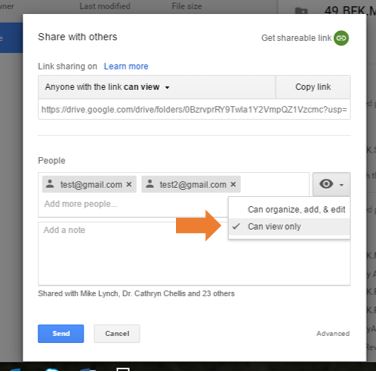Playbook for Desiging Collaborative Modules
BLTPN Playbook
Preparing Module Documents for Piloting Phase 4
Post-Pilot Phase - Preparing to Publish 7
Pre-Design Phase
Prior to designing the module, the design team will need to be selected and given an overview of the design process. Design members will also be provided access to professional development opportunities.
- The Design Team Lead will need to recruit and select designers for the project. (add district recruitment materials, if available)
- Design Team Leader assigns module ID number to designers. Design Team Leader completes all relevant fields in Module IDs: At a Glance Sheet.
- Design Team Leader will provide Module Design Folder access to all designers. Module Design Folders are located within each district’s folder:
- Each module folder will contain several pre-populated documents. Design Team Lead will review the purpose of each of these documents and the design process with the design team.
| File Abbreviation | Title of Document | Purpose of Document |
| MO | Module Overview | 1-2 page high level overview of module |
| MG | Module Guide | Detailed guide of module, think of this as a lesson plan |
| QAR1 | Quality Assurance Rubric | Internal review that is completed by designer(s) prior to external review and all official piloting |
| QAR2 | Quality Assurance Rubric | Internal review that is completed by designer(s) after all piloting |
| P1 | Pre-Assessment | Pre-Assessment of Module’s Learning Targets |
| P2 | Post-Assessment | Post-Assessment of Module’s Learning Targets |
| R# | Resource | Material needed to teach the pilot. Resources are numbered sequentially. |
| Sample# | Student Work Sample | Example of a student product along with the assessment of that product. Samples are numbered sequentially. |
| PilotTeacherFeedback | Pilot Teacher Feedback | Form that pilot teachers will complete to provide feedback to the designers. |
- Share P3 Templates with design team to use as tools to plan problem-based learning module. The P3 Templates originated from the Problems, Projects and Products workbook written by The PAST Foundation. These templates were the foundational pieces used to help original designers create relevant, rigorous problem-based modules.
- When PD Modules are available, share access to these modules with the designers for their optional use.
Design Phase
Now that the designers have the lay of the land, they can begin to work on designing the module. Design Team Leader should support the designers with checkpoints / timelines, ongoing feedback, resources, coaching, etc. to maintain momentum.
- Designer(s) will populate each component of the Module Guide.
- Designer(s) will create any applicable resources for the Module Guide. Any resources created for the module should be saved in the Module folder and follow the proper naming protocol: ModuleID.R1, etc.
- Designer(s) will populate each component of the Module Overview. Links to the Pre/Post Assessments can be found here.
- Once the module has been designed and developed, the Designer(s) will complete the Quality Assurance Rubric (QAR1). The designer(s) and Design Team Leader can also invite other internal educators to complete the QAR. The QAR1 will need to be downloaded to a computer and completed in an Adobe editor, like Adobe Acrobat or PDFescape. Once completed, the PDF will need to be saved to the hard drive and re-uploaded to the module folder. It should replace the QAR1 that was originally in the folder.
- Designer(s) makes modifications to module based on QAR review.
- Designer(s) will email Kate Heynoski to let her know that the learning targets are ready to be added to the Pre/Post Assessment.
- Design Team Leader will use the progress tracker to notify external review team that draft module is complete. Design Team Leader will need to complete the “Submitted for OSU Review” column in the progress tracker.
| Design Team | Progress Tracker Links |
| Forest Hills | http://tinyurl.com/design-tracker-FH |
| Lawrence County | http://tinyurl.com/design-tracker-LC |
| Mentor | http://tinyurl.com/design-tracker-MNTR |
| Northwestern | http://tinyurl.com/design-tracker-NW |
| Plain Local | http://tinyurl.com/design-tracker-PL |
| Worthington | http://tinyurl.com/design-tracker-W |
- The OSU Review Team will evaluate the module using the Quality Assurance Rubric. The OSU Review Team will upload the Quality Assurance Rubric to the Design Folder and call the file ModuleID.QARX. Once this has been completed, the OSU Review Team will update the progress tracker and a notification will be sent to the Design Team Leader.
- Design Team Leader will notify the designer(s) that the OSU review has been completed and that they can make revisions to the module based on feedback from OSU Review Team.
- After revisions have been made, designers are encouraged, although not required, to create a short video, using software like Screencastify,outlining their module for pilot teachers. This video should be used to help bring the module to life, prior to the pilot. Include the link to this short video in the module overview, or include the video file in the google doc folder.
- Design Team Lead will need to prepare the materials and assume responsibility for piloting.
Preparing Module Documents for Piloting Phase
There are two options when preparing pilot materials for pilot teachers. Both will be outlined below. Design Team Lead will choose the option that best fits their needs.
Option 1:
Design Team Lead will:
- Share Master folder with internal and external pilot teachers with “view only” privilege.
- Right Click on Folder and click “Share”
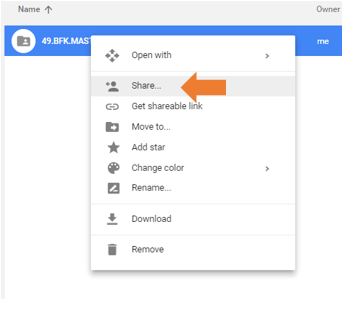
- Add email address for each pilot teacher and change the view option to “Can View Only”. This will grant users only access to view the files, not edit the files. Pilot teachers can download a copy to their own Google Drive, which can then be edited.
- Type a message/note if you wish and click “Send”.
- Share StudentProductSamples folder with internal and external pilot teachers with “edit” privilege. Since pilot teachers are expected to upload student sample work, they need to be able to organize, add, and edit materials in this folder.
- Right Click on Folder and click “Share”
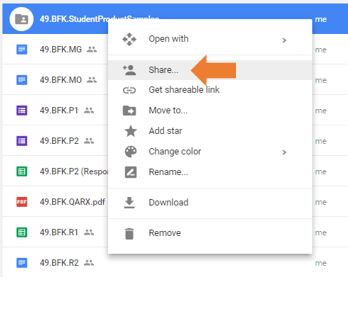
- Click”Advanced
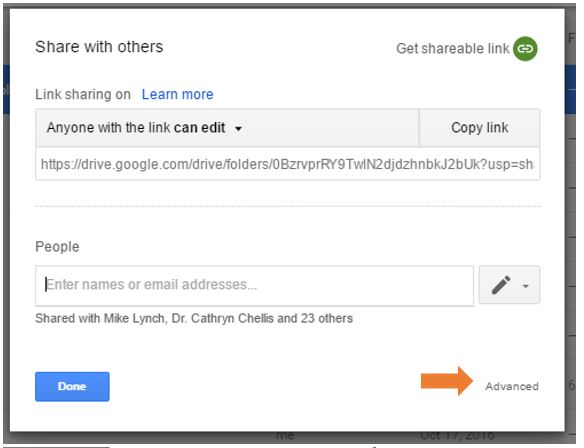
- Adjust the settings for each pilot teacher by clicking the pencil icon next to their name. Instead of “Can View Only” make sure “Can organize, add & edit” is selected. Click “Done”
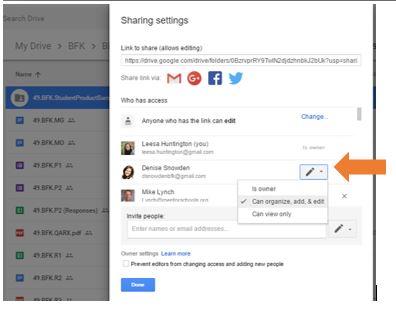
- If you would like the pilot teachers to be able to comment-only on the Module Guide,you can adjust the settings on that particular file.
- Right click on the Module Guide, Click Share, and then Click advanced.
- By each pilot teachers name, click the “eye” icon, and then select “can comment”.
- Click “Save Changes”
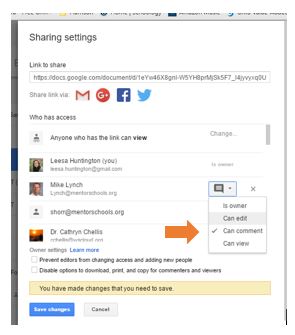
- Notify Design Team Leads at piloting districts that their piloting teachers have access to module materials.
- Optional: Notify Pilot teachers that they have access to materials. A sample email is available here.
Piloting Phase
- Design Team Lead will recruit classroom teachers to pilot modules. Each module will be piloted twice after teams have received feedback from the QARX (OSU Review Team) and made revisions.
- Pilot 1 (internal): The module will be taught by a teacher who works in the same district as the design team, but is not part of the design team for that specific module. Designers can teach their own module, but it will not count as the internal pilot. Note: In Lawrence County, the internal pilot can be taught by any teacher within Lawrence County.
- Pilot 2 (external): The module will be taught by a teacher who works in a different district than the design team, but is part of the BLTPN (Mentor, Forest Hills, etc.). Both design team members and non-design team members are eligible to pilot externally written modules.
- Compensation for all pilots will come from the pilot teacher’s district of residence. For example, if a Worthington teacher pilots a module written by a design team in Northwestern, Worthington will pay the teacher for the pilot.
Design Team Lead can use the Pilot Teacher Guidelines to provide requirements to interested teachers. Design Team Leads are encouraged to collaborate with other Design Team Leads to coordinate piloting efforts. Design Team Leads will be responsible for identifying and assigning internal and external pilot teachers. Design Team Leads should consider recruiting and selecting a variety of teachers to increase the exposure of the modules and generate interest.
| Name | District | Phone | |
| Trisha Underwood | Forest Hills | trisha.underwood@foresthills.edu | 513-317-7438 |
| Carol Raff | Plain Local | raffc@plainlocal.org | |
| Cathryn Chellis | Worthington | cchellis@wscloud.org | 614-450-6166 |
| Mike Lynch | Mentor | lynch@mentorschools.org | 440-205-8051 |
| Nicole McQuate | Northwestern | nrws_nmcquate@tccsa.net | |
| Betsy Fannin | Lawrence County | betsy.fannin@lc.k12.oh.us | 740-821-1701 |
- Design Team Lead will update the Module ID: At a Glance Reference to include the names and emails of the teachers who will be internally piloting modules as well as externally piloting modules.
- Design Team Lead will contact Pilot teachers to ensure they have access to Pilot Module Folder (ModuleID.PilotTeacherLastName) or have view only access to the Master Module folder .
- Design Team Lead will coordinate the administration of the 21st Century Skills pre- and post-assessments to all 7th and 8th grade students who are participating in a module pilot.
- 21st Century Skills Pre-Assessment link: https://www.surveymonkey.com/r/21stCentSkills
The pre-assessment is to be completed by students before all piloting begins. In the 2016-17 school year, this needs to be completed by the end of January. In the 2017-18 school year, this needs to be completed by the end of September. - 21st Century Skills Post-Assessment link: https://www.surveymonkey.com/r/21stCentSkillsPost
The post-assessment is to be completed by students in April or May once all piloting has ended for the school year.
- Once a teacher within their district has completed piloting (internal or an external pilot) Design Team Lead will update the Module IDs at a Glance spreadsheet by changing the cell color of that pilot teacher’s name to “green” to signify that they have completed the pilot. The Design Team Lead will use this information to let their Module designers know that they can begin refining their module. (see below)

(in the photo above, Worthington Design Lead has changed the cell color for Beth & Tony to green, which lets Plain Local know that these teachers have completed all requirements of piloting)
Pilot Teacher Guidelines
These are the same guidelines that exist in the Pilot Teacher Guideline Document that has been included as a link in each of the Module Overview documents.
- Pilot teacher will read module in its entirety prior to implementation, secure all technology needs, and coordinate with your district’s Design Team Lead to ensure all students have completed the Pre-Assessment of 21st Century Skills.
- Pilot teacher will administer Module Pre-Assessment based on module’s learning targets to all students (link is located in module overview). Because the Pre-Assessment is being administered to students across multiple schools and districts and collects student identifiable information, the results are not available to access. If you would like to see your students results to the Pre-Assessment, e-mail Kate Heynoski (kheynoski@bfk.org) to request this information.
- Pilot teacher will implement module in its entirety.
- Pilot teacher will Administer Module Post-Assessment based on module’s learning targets to all students (link is located in Module Overview). If you would like to see your students results to the Post-Assessment, e-mail Kate Heynoski (kheynoski@bfk.org) to request this information.
- Pilot teacher will provide feedback about their experience implementing the module using the Pilot Teacher Feedback Form (link in the Module Overview)
- Pilot teacher will collect and upload samples of student products (2-3) with completed scoring guide of the final products to the folder named “ModuleID.StudentProductSamples”. All student identifiers (names, student ID, etc.) should be redacted before submitting. Name these YourLastName.Sample1, YourLastName.Sample2, etc…
- Pilot teacher will send notification to Design Team Lead upon completion of the pilot
- Design Team Lead will update Progress Tracker with date of pilot completion and coordinates the administration of the 21st Century Skill Post-Assessment to students once all piloting has been completed in the spring.
- Pilot teacher will complete and submit all necessary documentation for compensation as per district requirements.
Post-Pilot Phase - Preparing to Publish
- Designers will read feedback from the Pilot Teacher Feedback Form, making edits and revisions to the module as needed. The Pilot Teacher Feedback Form sheet is located in the module folder.
- Designers will review all student product samples provided by the pilot teachers and select 2-3 student product samples to include in their final module.
- The product sample files will need to follow proper naming protocol (49.WCS.Sample1, 49.WCS.Sample2, etc.). Each product sample should include the student work along with the assessment of that work. All student work should be free of student identifiers. Designers will reference these samples in the Module Guide and include a brief description of each sample and a link to the sample and the assessment of that work. Example:
| Student Product Samples |
| Sample1 is a presentation created by a team of students sharing their solution on how their school can implement strategies to reduce their carbon footprint Sample Work Assessment |
- Designers will include these product samples in the Student Product Samples folder in the master module folder.
- Designers and the Design Team Lead need to verify the viability of all embedded links, accuracy of naming conventions of all documents,and completion of all aspects of the module guide and overview documents. Once everything has been verified, the final quality assurance review needs to be scheduled and master module folder shared with all reviewers.
- Designers will meet with the Design Team Lead (and any other Design Team Members) to conduct and complete the QAR2. This review serves as the final opportunity for quality feedback to strengthen the module prior to publishing. This must be a collaborative effort. If additional changes need to be made as a result of the QAR2, complete these updates and re-score the QAR2.
- If any learning targets have been updated, Kate will need an email that includes the new learning targets along with the Module ID so that she can update the P1/P2
- Design Team Lead updates the progress tracker that the QAR2 has been completed. This indicates that the master module folder is ready to publish.
- Design Team Lead will also update the Module ID at a glance
Post-Pilot Phase - Publish[a]
- Module files will be converted from Google Docs to Word, Excel, etc… and downloaded to the computer hard drive. This includes the following files:
- Module Guide - to be saved as a Word Document
- Resources - to be saved as appropriate file type (Word, Excel, PowerPoint, audio, etc..)
- Student Artifacts - to be saved as appropriate file type (Word, Excel, JPG, PowerPoint, audio, etc..)
- Converting files can be done several different ways. One way is to right click on the file name and select “Download”. This will save the file to your hard drive. Make note of where the file is saved.
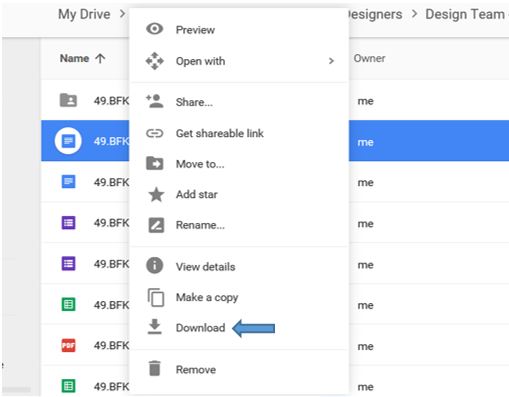
- Lead Designer will upload the module’s contents into it’s pre-labeled module folder within the Resource folder of the Module Designers Group on Schoology. Within this ModuleID folder will also be a StudentProductSamples folder that will contain student artifacts from piloting.
- A web page will be developed that will communicate an overview of the project as well as a description of each module, which will be the description from the Module Overview. Directions to access, download, and export modules to common cartridge will be provided.
- Modules (teacher facing) will be public resources and contain materials created by module designers as part of this project
- Modules (student facing) will be public resources and designed by teachers that electively chose to create these for their own use and for the benefit of others. This is not a requirement of the grant
- All materials uploaded to Schoology as a result of this project will be made public so that any educator can save these to their personal resource folder. They can access and use these modules within Schoology. Alternatively, they could export the module folder as a common cartridge folder and then import into another Learning Management System (LMS) that supports common cartridge.
[a]Look into OER
